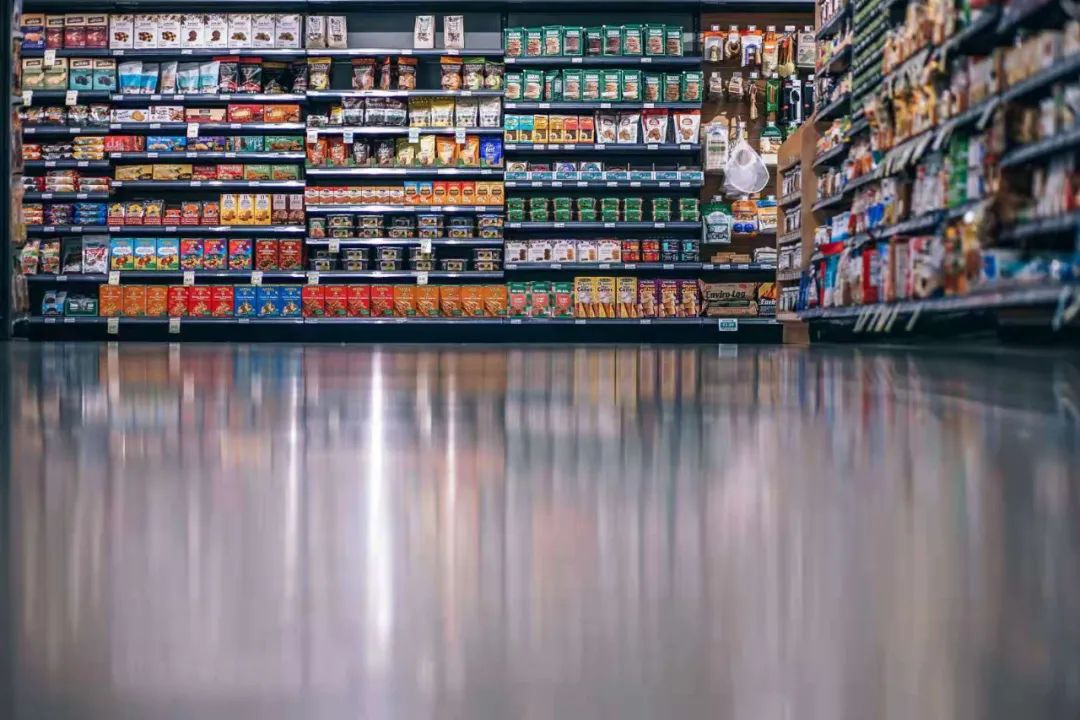(附代码)实战 | 基于OpenCV使用模板匹配识别空闲货架
假设你是一名在超市工作的员工,被要求在商店里四处走动,检查需要重新进货的货架。但是,超市有时会有多个区域来存放一种特定的产品,所以要跟踪购物者购买产品的确切位置并不容易。最重要的是,报告库存的空货架空间可能非常耗时,而且总是存在人为缺陷的可能性。这就是通过计算机视觉识别空的货架空间可能会派上用场的地方。
我们创建两个独特的模板并遍历图像以找到足够相似的多维数组。相似度是基于我们可配置的阈值。OpenCV的模板matchTemplate函数可以实现该操作。

有一些方法可以通过计算机视觉来实现这一点,有些比其他的更好,然而,在这篇文章中,我们将尝试OpenCV中的模板匹配。
模板匹配是一种在较大的图像中搜索和查找模板图像位置的方法。OpenCV附带了一个函数cv.matchTemplate()为这个目的。它简单地将模板图像滑动到输入图像上(就像在2D卷积中一样),并在模板图像下比较输入图像的模板和补丁。
模板匹配的第一步是创建我们的模板。当看到上面的照片,我们可以立即识别出中间顶部的两个架子有空余的空间。在最上面的架子上,我们可以确定有3-5个白色的bag产品需要重新进货。在第二个架子上,我们可以看到大约有两种产品需要重新进货。
首先,让我们用Python加载以下图片:
import cv2import matplotlib.pyplot as pltimport numpy as npimg = cv2.imread("/content/drive/MyDrive/Computer Vision/new_shelf.jpg")plt.figure(figsize = (20,15))plt.imshow(img)
下面是创建特定模板的代码(注意template_2由于空置面积较小,更窄):
template_1 = img[60:270, 1890:2010]plt.imshow(template_1)template_2 = img[300:500, 1825:1905]plt.imshow(template_2)
如果你想的话,你可以调整模板的大小,我觉得这些是最合适的。此外,如果你想知道为什么模板颜色看起来不同于原始图像,这是因为CV2作为加载图像BGR而不是RGB。
匹配过程
现在我们有了模板,我们可以开始匹配过程了。为此,我们首先将模板存储为一个具有不同属性的类,例如标签(1,2)和颜色(以区分为不同模板绘制的矩形框)。再次,巨大的呼喊Jean Rovani’s模板匹配博客和代码:
*******************************************************************/* Title: template_defenition.py* Author: Jean Rovani* Date: 2020* Code version: 3rd revision* Availability: https://gist.github.com/jrovani/012f0c6e66647b4e7b844797fa6ded22#file-template_definition-py*******************************************************************/DEFAULT_TEMPLATE_MATCHING_THRESHOLD = 0.85class Template:def __init__(self, label, template, color, matching_threshold=DEFAULT_TEMPLATE_MATCHING_THRESHOLD):self.label = labelself.color = colorself.template = templateself.template_height, self.template_width = self.template.shape[:2]self.matching_threshold = matching_thresholdimage = cv2.imread("/content/drive/MyDrive/Computer Vision/shelf_new.jpg")templates = [Template(label="1", template = template_1, color=(0, 0, 255)),Template(label="2", template = template_2, color=(0, 255, 0))]
接下来,我们遍历图像,并存储满足或超过阈值要求。
*******************************************************************/* Title: plot_bounding_boxes.py* Author: Jean Rovani* Date: 2020* Code version: 6th revision* Availability: https://gist.github.com/jrovani/099f80a5ee75657ff7aa6ed491568f04#file-plot_bounding_boxes-py*******************************************************************/detections_1 = []detections_2 = []for template in templates:template_matching = cv2.matchTemplate(template.template, image, cv2.TM_CCOEFF_NORMED)match_locations = np.where(template_matching >= template.matching_threshold)for (x, y) in zip(match_locations[1], match_locations[0]):match = {"TOP_LEFT_X": x,"TOP_LEFT_Y": y,"BOTTOM_RIGHT_X": x + template.template_width,"BOTTOM_RIGHT_Y": y + template.template_height,"MATCH_VALUE": template_matching[y, x],"LABEL": template.label,"COLOR": template.color}if match['LABEL'] == '1':detections_1.append(match)else:detections_2.append(match)
现在我们有了探测的所有数据,让我们看看它们在原始图像上是什么样子的cv2.rectangle功能:
image_with_detections = image.copy()for temp_d in [detections_1, detections_2]:for detection in temp_d:cv2.rectangle(image_with_detections,(detection["TOP_LEFT_X"], detection["TOP_LEFT_Y"]),(detection["BOTTOM_RIGHT_X"], detection["BOTTOM_RIGHT_Y"]),detection["COLOR"],2,)plt.figure(figsize = (20,15))plt.imshow(image_with_detections)
我们有发现了!这里的问题是检测List正在存储副本。为了解决这个问题,我们只需要确保我们只会使用一个不与其他矩形重叠的矩形:
消除重复检测
#Sorting detections by BOTTOM_RIGHT_X coordinatedetections_1 = sorted(detections_1, key = lambda i: i['BOTTOM_RIGHT_X'])detections_2 = sorted(detections_2, key = lambda i: i['BOTTOM_RIGHT_X'])det_wo_dupl_1 = [detections_1[0]]det_wo_dupl_2 = [detections_2[0]]check = 1min_x_1 = templates[0].template.shape[1]min_x_2 = templates[1].template.shape[1]for d in range(1, len(detections_1)):min_x_check = detections_1[d]["BOTTOM_RIGHT_X"] - detections_1[d-check]["BOTTOM_RIGHT_X"]if min_x_check > min_x_1:det_wo_dupl_1.append(detections_1[d])check = 1else:check += 1check = 1for d in range(1, len(detections_2)):min_x_check = detections_2[d]["BOTTOM_RIGHT_X"] - detections_2[d-check]["BOTTOM_RIGHT_X"]if min_x_check > min_x_2:det_wo_dupl_2.append(detections_2[d])check = 1else:check += 1det_wo_dupl = det_wo_dupl_1 + det_wo_dupl_2print(len(det_wo_dupl))
过滤检测
image_with_detections = image.copy()min_x = templates[0].template.shape[1]for detection in det_wo_dupl:cv2.rectangle(image_with_detections,(detection["TOP_LEFT_X"], detection["TOP_LEFT_Y"]),(detection["BOTTOM_RIGHT_X"], detection["BOTTOM_RIGHT_Y"]),detection["COLOR"],20,)plt.figure(figsize = (20,15))plt.imshow(image_with_detections)
有人可能会说,实际上应该有5个矩形显示在最上面的架子上,因为其中一个袋子似乎是轻微倾斜/移动。如果使用模板匹配,就很难找到这种方法。我们需要多个不同尺寸的模板来捕获这张图片中的所有空货架区域。

尽管模板匹配在我们这里的用例中工作得很好,并且对于许多其他用例来说是一个很棒的计算机视觉过程,但它可能不是这个场景的最佳选择。对于这样的问题,我们需要一种算法,可以学习理解一个空区域的周围乘积。这将允许更大的灵活性,因为它将能够处理不同大小/颜色的空白区域。
✄------------------------------------------------
双一流大学研究生团队创建,一个专注于目标检测与深度学习的组织,希望可以将分享变成一种习惯。
整理不易,点赞三连!
